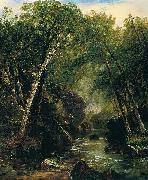Wholesale Oil Painting No Minimum |
|||||||||||
|
|
|||||||||||

|
|||||||||||
|
|
|
||||||||
John Frederick KensettAmerican Hudson River School Painter, 1816-1872 He attended school at Cheshire Academy, and studied engraving with his immigrant father, Thomas Kensett, and later with his uncle, Alfred Dagget. He worked as engraver in the New Haven area until about 1838, after which he went to work as a bank note engraver in New York City. In 1840, along with Asher Durand and John William Casilear, Kensett traveled to Europe in order to study painting. There he met and traveled with Benjamin Champney. The two sketched and painted throughout Europe, refining their talents. During this period, Kensett developed an appreciation and affinity for 17th century Dutch landscape painting. Kensett and Champney returned to the United States in 1847. After establishing his studio and settling in New York, Kensett traveled extensively throughout the Northeast and the Colorado Rockies as well as making several trips back to Europe. Kensett is best known for his landscape of upstate New York and New England and seascapes of coastal New Jersey, Long Island and New England. He is most closely associated with the so-called "second generation" of the Hudson River School. Along with Sanford Robinson Gifford, Fitz Hugh Lane, Jasper Francis Cropsey, Martin Johnson Heade and others, the works of the "Luminists," as they came to be known, were characterized by unselfconscious, nearly invisible brushstrokes used to convey the qualities and effects of atmospheric light. It could be considered the spiritual, if not stylistic, cousin to Impressionism. Such spiritualism stemmed from Transcendentalist philosophies of sublime nature and contemplation bringing one closer to a spiritual truth. |
||||||||
|
|
||||||||
Trout Fisherman
Trout Fisherman Painting ID:: 85806 |
Date 1852(1852)
Medium Oil on canvas
Dimensions 49.5 x 40.6 cm (19.5 x 16 in)
cjr Date 1852(1852) Medium Oil on canvas Dimensions 49.5 x 40.6 cm (19.5 x 16 in) cjr |
|||||||
|
|
||||||||
John Frederick KensettAmerican Hudson River School Painter, 1816-1872 He attended school at Cheshire Academy, and studied engraving with his immigrant father, Thomas Kensett, and later with his uncle, Alfred Dagget. He worked as engraver in the New Haven area until about 1838, after which he went to work as a bank note engraver in New York City. In 1840, along with Asher Durand and John William Casilear, Kensett traveled to Europe in order to study painting. There he met and traveled with Benjamin Champney. The two sketched and painted throughout Europe, refining their talents. During this period, Kensett developed an appreciation and affinity for 17th century Dutch landscape painting. Kensett and Champney returned to the United States in 1847. After establishing his studio and settling in New York, Kensett traveled extensively throughout the Northeast and the Colorado Rockies as well as making several trips back to Europe. Kensett is best known for his landscape of upstate New York and New England and seascapes of coastal New Jersey, Long Island and New England. He is most closely associated with the so-called "second generation" of the Hudson River School. Along with Sanford Robinson Gifford, Fitz Hugh Lane, Jasper Francis Cropsey, Martin Johnson Heade and others, the works of the "Luminists," as they came to be known, were characterized by unselfconscious, nearly invisible brushstrokes used to convey the qualities and effects of atmospheric light. It could be considered the spiritual, if not stylistic, cousin to Impressionism. Such spiritualism stemmed from Transcendentalist philosophies of sublime nature and contemplation bringing one closer to a spiritual truth. |
||||||||
|
|
||||||||
|
|
Trout Fisherman
Trout Fisherman Painting ID:: 90435 |
oil on canvas.
1852
cjr oil on canvas. 1852 cjr |
||||||
|
|
||||||||
|
John Frederick Kensett American Hudson River School Painter, 1816-1872 He attended school at Cheshire Academy, and studied engraving with his immigrant father, Thomas Kensett, and later with his uncle, Alfred Dagget. He worked as engraver in the New Haven area until about 1838, after which he went to work as a bank note engraver in New York City. In 1840, along with Asher Durand and John William Casilear, Kensett traveled to Europe in order to study painting. There he met and traveled with Benjamin Champney. The two sketched and painted throughout Europe, refining their talents. During this period, Kensett developed an appreciation and affinity for 17th century Dutch landscape painting. Kensett and Champney returned to the United States in 1847. After establishing his studio and settling in New York, Kensett traveled extensively throughout the Northeast and the Colorado Rockies as well as making several trips back to Europe. Kensett is best known for his landscape of upstate New York and New England and seascapes of coastal New Jersey, Long Island and New England. He is most closely associated with the so-called "second generation" of the Hudson River School. Along with Sanford Robinson Gifford, Fitz Hugh Lane, Jasper Francis Cropsey, Martin Johnson Heade and others, the works of the "Luminists," as they came to be known, were characterized by unselfconscious, nearly invisible brushstrokes used to convey the qualities and effects of atmospheric light. It could be considered the spiritual, if not stylistic, cousin to Impressionism. Such spiritualism stemmed from Transcendentalist philosophies of sublime nature and contemplation bringing one closer to a spiritual truth. Trout Fisherman oil on canvas. 1852 cjr |
||||||||
|
|
||||||||
|
Prev Next
|
||||||||
|
|
||||||||
|
Related Paintings to John Frederick Kensett :. |
||||||||
|
|
||||||||
|
CONTACT US |


